How Well Did Vegas Pull Off Its First F1 Race? Depends Who You Ask
The first free practice session at Formula 1’s Las Vegas Grand Prix opened exactly as everyone expected—problematically. High drama ensued almost right away, when FIA officials declared the session canceled after Ferrari driver Carlos Sainz’s engine and chassis went up in smoke only nine minutes into the inaugural round of high-speed lapping.
As fans wandered about the strip wondering what had actually happened, the mystery played out on TV screens. Apparently, a drainage cover sucked up by the race car's downforce smashed Sainz’s engine and undercarriage, forcing a crew of workers to then check and reinforce every remaining cover on the road circuit’s 3.85 miles of public asphalt.
Not quite an auspicious start, to say the least, and seemingly proof-positive to all the Vegas naysayers poo-pooing F1’s latest addition to the U.S. expansion. The advance criticism of choosing Sin City as a third American venue centered around understandable forecasts of drunk spectators focusing more on partying and celebrity appearances than the racing event itself. Despite half of the city’s ensnarled roads shutting down in the name of sport, Vegas would still be Vegas, right?
I attended hoping to witness the debacle and debauchery first hand, my mind preoccupied by visions of some intoxicated fool stumbling out onto the strip and getting a limb removed by a carbon-fiber front splitter. I joined hosted media as a guest of Heineken in the heavily branded paddock and so-called Heineken House, a temporary structure that required almost a full year of planning to erect before race weekend.
Ads for Heineken’s alcohol-free 0.0 variant and a light new Silver lager bedecked almost every flat surface around Vegas, not to mention the massive curved displays of The Sphere, as the Dutch beer conglomerate hoped to attract a younger crowd in the vein of music festivals and concerts than late-night whisky sipping F1 aficionados. F1 as a whole, meanwhile, continued catering to the reality-show nature of Netflix’s Drive to Survive series, with early reservations for tickets to F1 Vegas creeping up well into four figures. After all, race car drivers duking it out on the lit-up strip sounds pretty hard to beat for views of Instagram reels and TikTok vids.
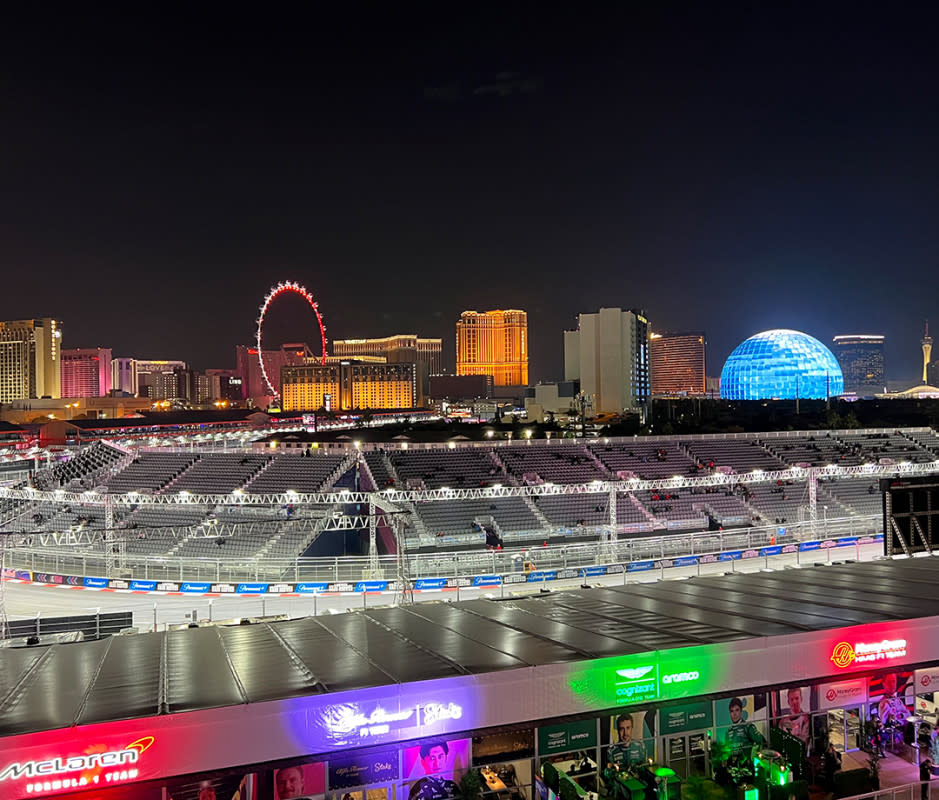
Michael Teo Van Runkle
Shutting Down the Las Vegas Strip
The challenges this city faced to handle the logistics of dropping an F1 race into central Vegas's famously snarled gridlock may not have helped ticket prices. And by the time the stillborn Free Practice 1 started, most spectators who'd arrived early discovered ways to watch from escalators, bridges, and elevated walkways without even needing assigned grandstand seats.
Each evening, the festivities kicked off with short concerts and big beats thumping as scantily clad dancers gyrated on stages around the city. In the Paddock Club, meanwhile, celebrity sightings ran the gamut—with Brad Pitt, Usain Bolt, David Beckham, Shaquille O’Neal, Rihanna, and James Corden in the mix. A glass house tucked in just behind the paddock even hosted blackjack and roulette tables, plus an altar where an Elvis impersonator offered dubiously legal wedding services.
All the partying seemed lost on the race teams and drivers though, none more-so than already confirmed 2023 season champion Max Verstappen, who delivered not-so-gold quotes about the city, the track, and the fans throughout interviews leading up to the race.
Related: You Won't Believe What Today's F1 Stars Drive After Work
"I love Vegas," qualified Verstappen, before lacing into the place as a debatable F1 venue. "But the emotion, passion—it's not there like some of the old-school tracks.
"Most people just come here to party, drink, see a DJ play, or watch a performance," he added. "They don't actually understand what we're doing or putting on the line."
Rather than the classy yachts of Monaco or the hilly forests of Spa-Francorchamps, drivers racing at Vegas faced the prospect of chilly track temperatures, streaking neon light reflections, and cartoon faces looking down from The Sphere as distractions from speeds of up to 220 miles per hour. On TV, the setting took on a much more picturesque appeal, as Verstappen’s friend, Dutch DJ Martin Garrix, recalled just before the race on Saturday night.
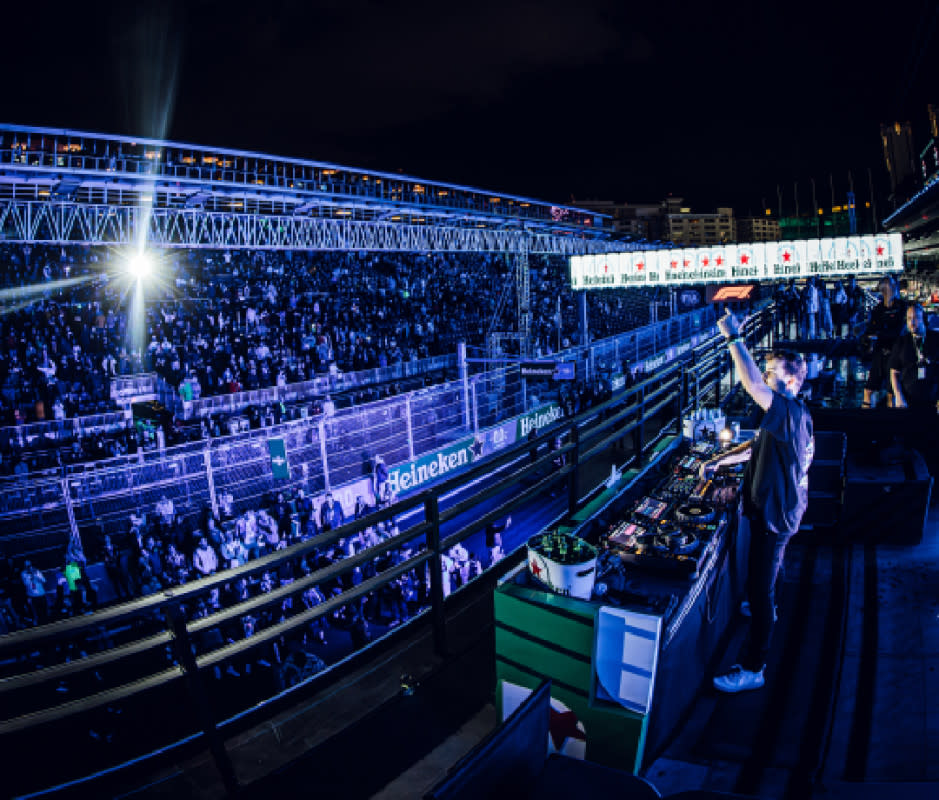
Heineken
"That drone shot of the race cars last night—with the Bellagio fountains suddenly shooting up," said Garrix. "I remember looking at the TV, and thinking, ‘How the fuck is this real?' It looked animated."
“Personally, I'd love to see a few more turns, make it cooler to overtake, have it a little bit more competitive racing-wise,” Garrix added, before hedging a bit. “This is the first year here, and to think about what they did in the last 10 months preparation-wise to pull it off ... It's not 100-percent perfect yet, but I do think this could grow into one of the craziest races of the F1 calendar.”
I asked Garrix if he thought that given the cold temps, tight walls, and overall spectacle, Verstappen might just switch off the competitive fire and let the race run away. Not so much, he predicted.
“F1 is such a crazy sport—and you have to set such determination, such focus, that I think it's hard to switch off,” Garrix said, “I have a hard time switching off after a show. I won't be able to sleep for the next few hours.”
And would the famously stoic Verstappen go out for a night on the town afterward? "He's gonna party tonight, of course," his friend confided. "I'm meeting him later.”
Related: The Best Watches Worn by Top Athletes
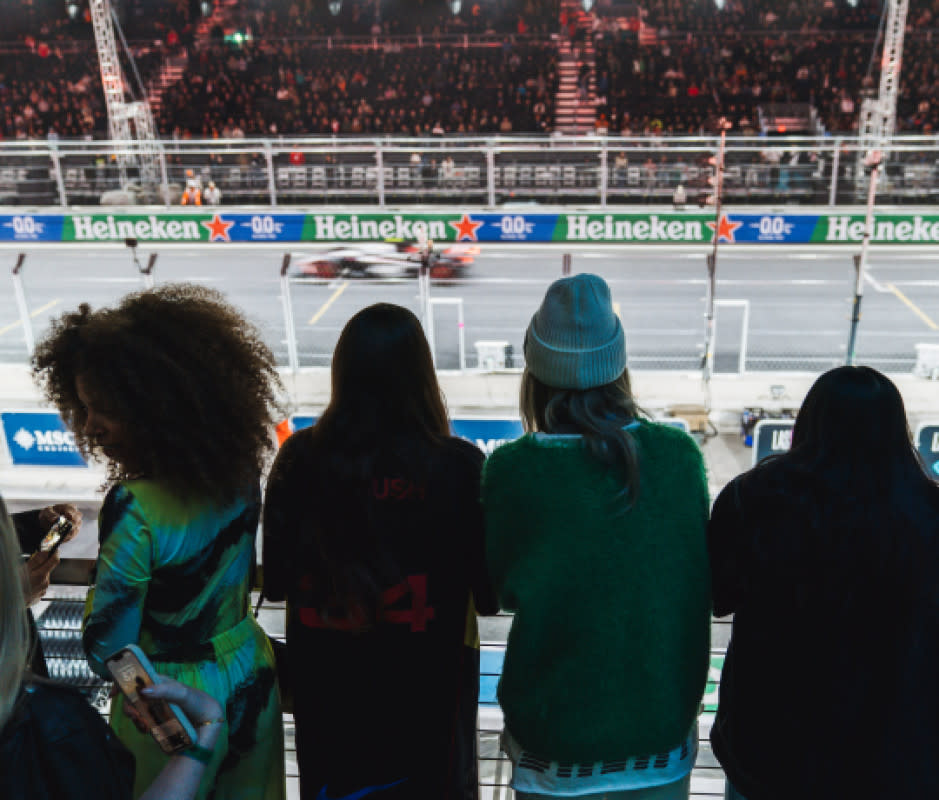
Heineken
All Eyes on the Main Event
After two days staying out well past midnight, I arrived at the main event on Saturday, prepared to watch another few hours of concerts, DJ sets, and F1 racing. At the Heineken House, DJ Pee .Wee (aka Anderson .Paak) spun classic vinyl for almost an hour. Drinks and martinis flowed as crowds swelled far beyond the practice sessions—though not nearly to the point of feeling full. The grid showed promise, everyone seemed to agree, after Ferrari’s other driver Charles Leclerc set down the pole time, followed by Sainz who took a 10-position penalty that the FIA levied despite the drainage cover fiasco being entirely outside his control.
As the Tifoso cried foul, though, a tantalizing starting lineup featured Verstappen in second, American Logan Sargeant in sixth, and eight-time champion Lewis Hamilton way down in 10th, presaging a potentially exciting race.
The promise paid off immediately, as Verstappen nudged Leclerc out of the way at Turn 1 and took the overall lead—only to find himself doled out a time penalty for the move. Lando Norris, meanwhile, crashed his McLaren in lap three, as Sainz drove like mad to work up to sixth position, with Hamilton edging into seventh. After serving a five-second penalty, Verstappen found himself once again behind Leclerc and pushed hard to make a second pass with only 13 laps remaining.
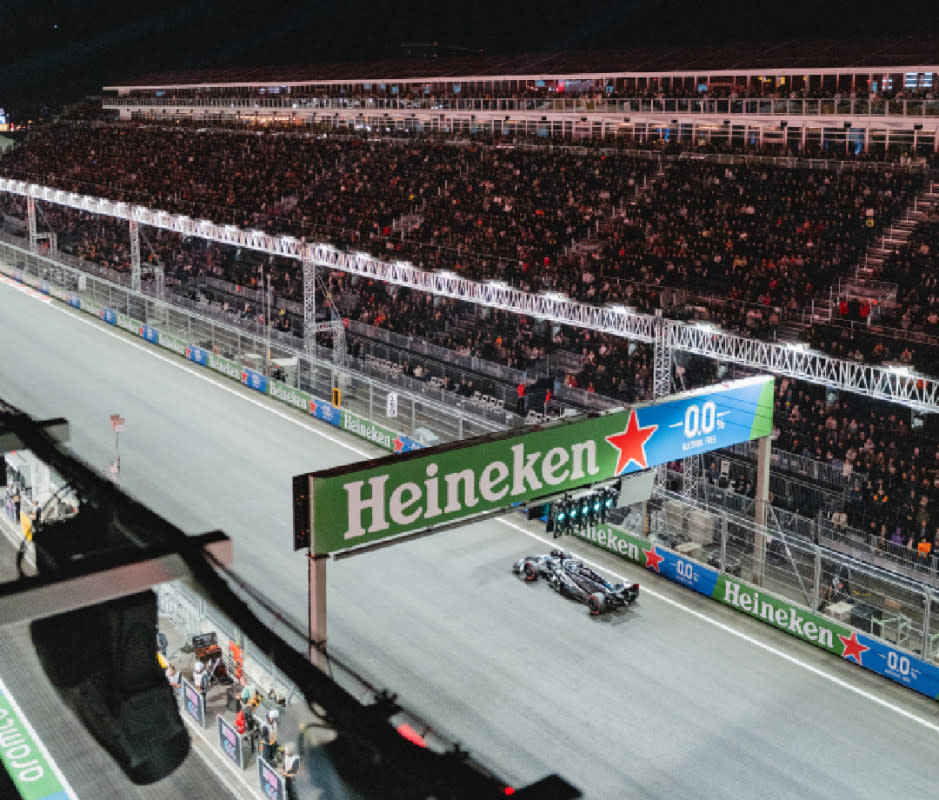
Heineken
The total of 50 laps ended in about an hour and a half, with average speeds over 140 mph and 16 cars crossing the finish line behind Verstappen. Fans who shelled out for expensive tickets to the Grand Prix, many of whom found themselves ejected from the stands before Free Practice 2 when the FIA deemed every drainage cover safe around 2 a.m. on Friday morning, ended up getting a show packed full of exciting action—despite Verstappen and Red Bull having wrapped up the driver and constructor championships last month.
Garrix himself DJ’d the closing ceremony as champagne flowed and crowds filtered out toward casinos and clubs. But for the partygoers and casual attendees in the streets and stands, did the Vegas experiment live up to the goals of expanding American viewership and awareness of F1? I spoke with a doctor at the Heineken House who bought tickets on something of a whim while visiting family.
“I don’t know anything about F1, but I've been to Vegas a hundred thousand times and it's almost like a second home to me," said attendant Swathi Challa, after experiencing her first motorsport event. “I think they're doing a really good job of controlling things—and I don't think the traffic's that bad. It didn't take me that long to get here. The cars are going by so fast, so I'm watching mostly on the screen," she added.
Related: Best American Whiskeys at 2023 SF World Spirits Competition
As a frequent Vegas vacationer, would she do F1 again? Or just go gambling at the casinos, or watch strippers at a club?
“Depends on the stripper,” she said. “I think this was worth the money on some level—but not as packed as I thought it would be.”
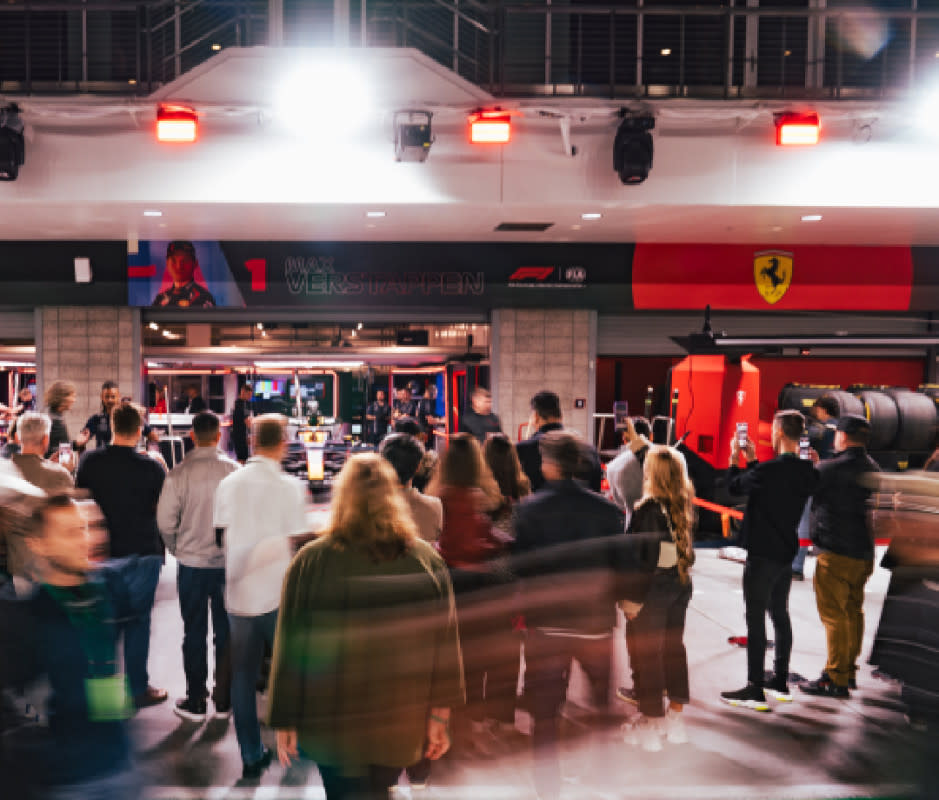
Heineken
A Surprisingly Smooth Vegas Experiment
How well did the Vegas F1 experiment work? Opinions vary, and picking the right place to watch the race—on the hairpin at Turn 1, for example—would probably have been a bit more fun. But even the usually dour Verstappen mustered some succinctly positive words after taking the win.
“It was a fun race—I enjoyed it,” Verstappen said. “Excited to come back here next year and try to do something similar.”
First-year growing pains might have been predictable, but after the early debacle in Free Practice 1, everyone I spoke to believed the rest of the weekend went surprisingly smoothly. (Just don’t ask McLaren about the alleged bumps that sent Norris into a wall.) Next time around, spectators will know they can potentially skip shelling out big bucks for tickets, or hold off on booking hotels until the last minute. Personally, I’ll try to avoid staying out past 3 a.m. next time, in the hopes that recovering the following morning won’t ruin an entire day on the (heavily delayed) flight home.
Then again, maybe FIA will switch the plan and hold the race on Sunday morning next year. Sounds more fun to me, though my priorities won't be boosting revenue at the roulette table as spectators inevitably swing through casinos after the closing ceremonies wind down. I'm still doubling down on day drinking and poolside cabanas, even if Sin City in the sunlight can’t hope to match the photogenic appeal of the world’s fastest race cars zooming down the Vegas strip at top speed after sunset.
